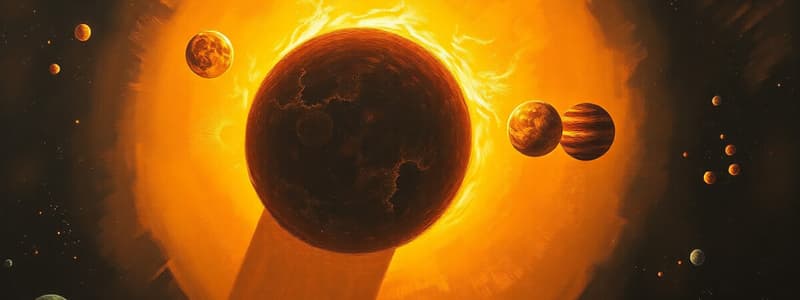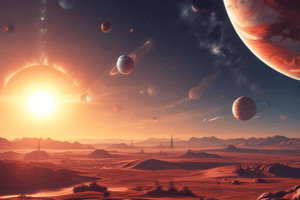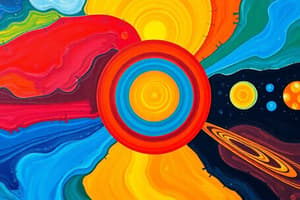Podcast
Questions and Answers
On a scale of 1:90,000,000, the sun would be roughly the size of a typical car.
On a scale of 1:90,000,000, the sun would be roughly the size of a typical car.
False (B)
In a 1:90,000,000 scale model of the solar system, Jupiter, the largest planet, would be about the size of a kitchen table.
In a 1:90,000,000 scale model of the solar system, Jupiter, the largest planet, would be about the size of a kitchen table.
True (A)
The heliocentric model of the universe places the Earth at the center, with all other celestial bodies orbiting around it.
The heliocentric model of the universe places the Earth at the center, with all other celestial bodies orbiting around it.
False (B)
The geocentric model of the universe originated in Ancient Rome.
The geocentric model of the universe originated in Ancient Rome.
Ptolemy's model of the universe accurately explained retrograde motion by positing planets moved in perfect circles around the Sun.
Ptolemy's model of the universe accurately explained retrograde motion by positing planets moved in perfect circles around the Sun.
Arabic astronomers heavily supported the Ptolemaic model and never questioned its accuracy.
Arabic astronomers heavily supported the Ptolemaic model and never questioned its accuracy.
Newton's law of gravitation explains that attraction between objects is inversely related to their masses.
Newton's law of gravitation explains that attraction between objects is inversely related to their masses.
The Sun comprises six distinct layers, categorized into three inner and three outer layers.
The Sun comprises six distinct layers, categorized into three inner and three outer layers.
Energy production in the Sun's core is driven by nuclear fission.
Energy production in the Sun's core is driven by nuclear fission.
Venus is unique as the only planet in our solar system that rotates in a clockwise direction and is recognized as the most luminous planet from Earth.
Venus is unique as the only planet in our solar system that rotates in a clockwise direction and is recognized as the most luminous planet from Earth.
Approximately 90% of Earth's surface is covered with water, and it features a magnetic field concentrated at both poles.
Approximately 90% of Earth's surface is covered with water, and it features a magnetic field concentrated at both poles.
Mars is known as the 'Blue Planet' due to its color and is identified as having two moons.
Mars is known as the 'Blue Planet' due to its color and is identified as having two moons.
Inner planets are primarily composed of lighter elements like hydrogen and helium, similar to the outer planets, but on a smaller scale.
Inner planets are primarily composed of lighter elements like hydrogen and helium, similar to the outer planets, but on a smaller scale.
The outer planets—Jupiter, Saturn, Uranus, and Neptune—share common traits, including formation from icy and gaseous materials, rings, and multiple moons.
The outer planets—Jupiter, Saturn, Uranus, and Neptune—share common traits, including formation from icy and gaseous materials, rings, and multiple moons.
A scale model accurately represents the relative lengths and widths of modeled objects, but not necessarily their heights.
A scale model accurately represents the relative lengths and widths of modeled objects, but not necessarily their heights.
Flashcards
Geocentric Model
Geocentric Model
A model of the universe where the Earth is at the center, and all other celestial bodies revolve around it.
Heliocentric Model
Heliocentric Model
A model of the universe where the Sun is at the center, and all planets revolve around it.
Retrograde Motion
Retrograde Motion
The apparent backwards motion of planets in the sky, caused by their different orbital speeds.
Ptolemaic Model
Ptolemaic Model
Signup and view all the flashcards
Newton's Law of Gravitation
Newton's Law of Gravitation
Signup and view all the flashcards
Earth's Gravity
Earth's Gravity
Signup and view all the flashcards
Heliocentric Model (Modern)
Heliocentric Model (Modern)
Signup and view all the flashcards
What is the core of the Sun?
What is the core of the Sun?
Signup and view all the flashcards
What is the radiative zone?
What is the radiative zone?
Signup and view all the flashcards
What is the convective zone?
What is the convective zone?
Signup and view all the flashcards
What is the photosphere?
What is the photosphere?
Signup and view all the flashcards
What is the corona?
What is the corona?
Signup and view all the flashcards
What are sunspots?
What are sunspots?
Signup and view all the flashcards
What are the terrestrial planets?
What are the terrestrial planets?
Signup and view all the flashcards
What is a scale model, in the context of the Solar System?
What is a scale model, in the context of the Solar System?
Signup and view all the flashcards
Study Notes
Sun's Structure and Layers
- The Sun has six layers: three inner (core, radiative zone, convective zone) and three outer (photosphere, chromosphere, corona).
- A transition zone separates the chromosphere and corona.
- Energy is produced in the core through nuclear fusion.
- The photosphere is the Sun's visible surface.
- The corona is visible during a total solar eclipse as a spiky ring.
Inner Planets
- Four inner planets: Mercury, Venus, Earth, Mars.
- Characteristics include smaller size, metal and silicate composition, faster orbital speeds.
- Mercury: Smallest, no atmosphere or moons.
- Venus: Hottest, spins clockwise, brightest in Earth's sky.
- Earth: 70% water coverage, magnetic field.
- Mars: Red planet, two moons.
- Inner solar system: Inner planets and asteroid belt separated from the outer solar system by a frost line.
Outer Planets
- Four outer planets: Jupiter, Saturn, Uranus, Neptune.
- Formation from icy and gaseous materials, characteristics include rings and many moons.
- Storms present on Jupiter and Neptune.
Scale Model of the Solar System
- A scale model preserves relative sizes and distances of solar system objects.
- Choosing a scale factor, e.g., 1:90,000,000, allows for a model representation.
- On this scale: Sun ≈ typical house, planets vary in size (Mercury = billiard ball to Neptune = large pizza).
- Distances are immense; e.g., Earth≈1 mile from the Sun, Neptune ≈ 30+ miles.
Geocentric vs. Heliocentric Models
- Geocentric model: Earth at the center, celestial bodies orbit Earth.
- Heliocentric model: Sun at the center, planets orbit the Sun.
- Geocentric model has ancient Greek origins.
- Earth was initially modeled as a cylinder, later identified as a sphere.
- Aristotle proposed a geocentric model with transparent spheres and uniform circular motion for celestial bodies.
- Ptolemy's geocentric model (Ptolemaic model) attempted to explain retrograde motion; planets on oscillating paths around Earth.
- The Ptolemaic model was challenged and eventually supplanted by the heliocentric model.
- Scientists like Copernicus, Galileo, Kepler, and Newton contributed to moving towards the heliocentric model.
Newton's Law of Gravitation
- Newton's law of gravitation states that every object attracts every other object in the universe due to its mass.
- Observed an apple falling to the ground to arrive at this law.
Studying That Suits You
Use AI to generate personalized quizzes and flashcards to suit your learning preferences.




